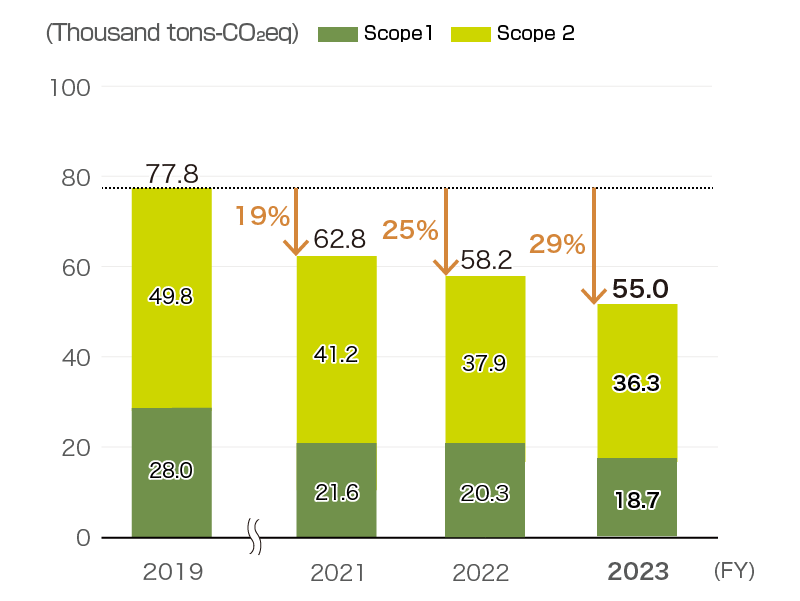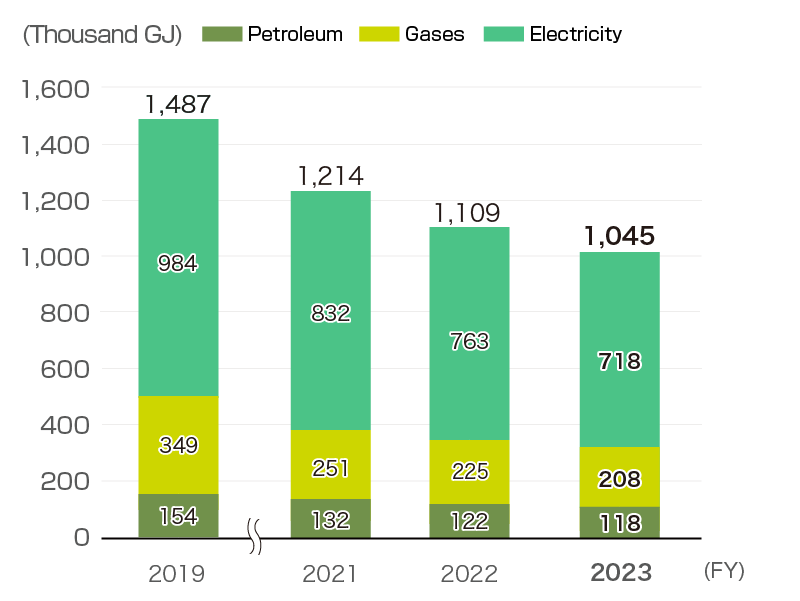
Environment Climate Change Initiatives
Climate change is an environmental problem that has a significant effect on the continued existence of life, including human beings, and efforts to prevent it are now a major challenge for the global community. Mitsubishi Tanabe Pharma Group has positioned climate change initiatives as an important management theme and is promoting the reduction of greenhouse gas (below, "GHG") emissions resulting from its business activities.
Reduction of GHG Emissions
Scope 1 + 2
To mitigate climate change, the Group is endeavoring to reduce its energy consumption and GHG emissions by preventing the leakage of fluorocarbons, and has set the following targets in the Medium-Term Environmental Action Plan 21-25.
GHG emissions (Global: Scope 1 + 2)
◇58% reduction in GHG emissions by fiscal 2025 compared to 2019
GHG emissions for all global bases in fiscal 2023 were 55.0 thousand t-CO2eq, down 29% compared to fiscal 2019.
This breaks down as: Scope 1 emissions directly from combustion by Mitsubishi Tanabe Pharma were 18.7 thousand t-CO2eq, a 33% reduction from fiscal 2019, with Scope 2 GHG emissions arising indirectly from the company due to use of electricity, etc., of 36.3 thousand t-CO2eq, a 27% reduction on fiscal 2019.
We will continue to promote daily energy conservation efforts at each base in order to achieve our goal of a 58% reduction.

Scope 3
Scope 3 GHG emissions in the supply chain emitted after sales and procurement of raw materials were largest in category 1, accounting for 95.6% of Scope 3. The Group has been working with other pharmaceutical companies to promote joint distribution of ethical drugs in Japan since fiscal 2022, which reduces the number of vehicles used for operations and thus lowers GHG emissions.
Scope 3 GHG emissions
| Category | GHG emissions (Thousand t-CO2eq) | Calculation method | |
|---|---|---|---|
| 1 | Purchased goods and services | 682.2 | Calculated from the purchase prices of raw materials and products in Japan, which are multiplied by the emissions unit values from the Ministry of the Environment database* |
| 2 | Capital goods | 17.1 | Calculated from acquisition amounts of property, plant and equipment, not only for domestic companies but also for overseas companies in the scope of consolidation, which are multiplied by the emissions unit values from Ministry of the Environment database* |
| 3 | Fuel- and energy-related activities not included in Scope 1 or 2 | 9.0 | Calculated from amount of energy used at domestic and overseas Group offices, which is multiplied by emissions unit values from Ministry of the Environment database* or the emissions unit values from the LCI database (IDEAv2.3) |
| 4 | Transport and delivery (upstream) | 2.3 | Calculated from domestic transportation ton-kilometers for shipments from plants to distribution centers, shipments from distribution centers to wholesalers, and shipments from sales-promotion item warehouses to branches, sales offices, etc., using the ton-kilometer method in the greenhouse gas emission calculation and reporting manual from Japan's Ministry of the Environment and Ministry of Economy, Trade and Industry Calculated from electricity used for storage management at outsourced distribution centers and sales-promotion item warehouses, multiplied by the actual emissions factor indicated in the emissions factors for electric power enterprises announced by the Ministry of the Environment and the Ministry of Economy, Trade and Industry on December 22, 2022 |
| 5 | Waste generated in operations | 1.3 | Calculated from the amounts of waste, by type, from domestic Group offices (production and research bases, headquarters/Tokyo Head Office, distribution centers, and sales offices), which are multiplied by emissions unit value from Ministry of the Environment database* |
| 6 | Business travel | 0.7 | Calculated from number of domestic and overseas employees, which is multiplied by the emissions unit value from Ministry of the Environment database* |
| 7 | Employee commuting | 1.1 | Calculated by multiplying the amount of transportation costs paid by domestic and overseas transportation districts by multiplying the emissions unit values from Ministry of the Environment database* |
| 12 | End-of-life treatment of sold products | 0.2 | Calculated from amount of recycling obligation based on the Containers and Packaging Recycling Law in Japan, which is multiplied by the emissions unit value from Ministry of the Environment database* |
| Total | 713.9 | ||
*Ministry of the Environment database: database on emissions unit values for calculating greenhouse gas emissions, etc., by organizations throughout the supply chain (Ver.3.4)
Reduction of Energy Used
The domestic Group holds regular energy liaison committee meetings for energy conservation to review changes in energy consumption and energy conservation measures as needed. We are also promoting energy conservation globally by creating an energy management system.
Energy use (thermal equivalent) has continued to drop thanks to a variety of energy-saving activities undertaken at each base, as well as the consolidation of bases.
Energy use (global)

Initiatives to Reduce GHG Emissions
Promoting carbon neutrality
In our carbon neutrality action formulated in fiscal 2023, we created a roadmap for the introduction of renewable energy, the switch to the use of next-generation vehicles as company-owned vehicles, and the conversion of fuels used in boilers and other large-scale equipment.
With regard to the introduction of renewable energy, we will promote the switch to renewable energy by moving to electric power from renewable energy sources at factories in Japan by 2025, and by all other offices in Japan by 2030.
Energy-Saving Initiatives at Bases
The Group is actively promoting energy conservation activities.
At our domestic and overseas bases, we are continuously replacing lights with LED lighting, controlling the blinking of lights with sensors, as well as promoting the update of energy saving equipment, and the shutdown of operations in manufacturing areas during long vacation periods. We are also engaged in daily energy-conserving activities such as energy-saving campaigns at all bases to educate employees and recommend turning off lights and equipment power when not in use.
- Environmentally friendly activities in fiscal 2023
Winner of the Chairman's Award in the 2023 NEDO Energy Conservation Technology Development Awards
Working with organizations from other industries, we evaluated the practical use of pharmaceutical manufacturing equipment using continuous batch production methods, and developed continuous production systems that offered an 80 percent reduction in energy use compared to other commonly used methods. This project, “Development of the iFactoryTM for the manufacture of pharmaceutical products based on the operation of interconnecting reconfigurable modular units,” was chosen for having the best theme and received the Chairman’s Award in the 2023 NEDO Energy Conservation Technology Development Awards, which are awarded to businesses that are deemed to have achieved excellent results in contributing to energy conservation.
See below for details.Awarded as an “NEDO Energy Conservation Technology Development Award” in ENEX2024
https://www.nedo.go.jp/news/press/AA5_101722.html
(Japanese language only)Supporting environmentally friendly products
The Company has adopted biomass plastic blister packages as our first environmentally friendly packaging material. These blister packages are a product from the Mitsubishi Chemical Corporation, another member of the Mitsubishi Chemical Group (MCG Group), and allow us to reduce carbon dioxide emissions by 30-70% compared to blister packages made from oil-derived plastic.
*Blister package: Also known as “Press Through Pack (PTP)” in Japan.
See below for details.Announcement of launch of SGLT2 inhibitor “Canaglu OD Tablets” - Adoption of Environmentally Friendly Biomass-plastic PTP sheets -
https://www.mt-pharma.co.jp/e/news/assets/pdf/e_MTPC240522.pdfManufacturing Pharmaceuticals that are Secure, Safe, and Convenient to Use
Introduction of Hybrid Vehicles
The Group is shifting steadily from gasoline-powered vehicles to hybrid vehicles and promoting eco-driving to reduce GHG emissions from company-owned vehicles (switch to hybrid vehicles planned for completion by fiscal 2027).
| FY2019 (Base year) |
FY2021 | FY2022 | FY2023 | ||
|---|---|---|---|---|---|
| Ratio of company-owned vehicles that are hybrid vehicles | 67% | 64% | 67% | 70% | |
| CO2 emissions from company-owned vehicle fuels (domestic) |
CO2 emissions | 4,165 t-CO2 | 3,576 t-CO2 | 3,520 t-CO2 | 3,597 t-CO2 |
| Ratio of reduction in CO2 emissions (compared to fiscal 2019) |
ー | 14% | 15% | 14% | |
Renewable Energy Use
Use of renewable energy that does not emit GHG is an effective measure to contribute to climate change mitigation.
The Group has installed solar power generating equipment at Mitsubishi Tanabe Pharma Korea (Hyangnam Plant), and carbon-free power has been installed at the Shonan Office and at some Group offices in Europe. Going forward, we will consider switching to electricity from renewable sources for procurement of power at other major Group bases, based on our carbon neutrality action plan.
Controlling Fluorocarbons Emissions
The Group is working to prevent leaks of fluorocarbons, which add to the effects of ozone layer depletion and greenhouse gases. Equipment containing fluorocarbons installed in domestic bases is properly managed with a ledger in accordance with the revised Law Concerning the Discharge and Control of Fluorocarbons which came into effect in 2020. In addition, we comply with installation standards and conduct regular equipment inspections and when disposing of the equipment, we recover and destroy the fluorocarbons and maintain a record of this for three years.
Furthermore, when installing equipment containing fluorocarbons, we select a model that takes into account global warming potential and energy-saving performance.
In fiscal 2023, at domestic production and research bases, the leakage volume of fluorocarbons was 43kg (74 t-CO2 equivalent.) The CO2-equivalent leakage volumes for domestic Group companies were below the threshold for reporting to the national government for all years since 2015 when the leakage reporting system was established.
